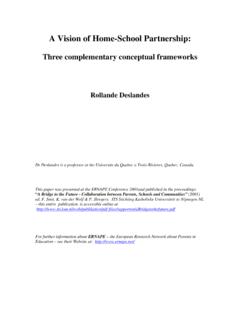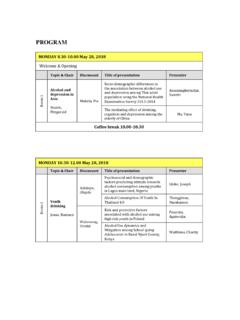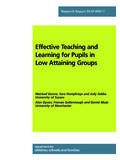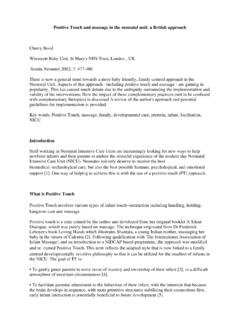Transcription of CHAPTER Family Influences on Delinquency
1 CHAPTER CHAPTER OBJECTIVES203 IntroductionWhen people are asked what they think are the main causes of crime, they often nominate poor parental child-rearing methods, and especially poor discipline or control of children (see Farrington, 2002). For example, in 1988, the British news-paper Mail on Sunday reported the results of a survey of a quota sample of over 1,000 adults who were asked what they thought were the main causes of violent crime. The most popular cause (nominated by 53 percent) was lack of parental discipline, followed by poverty (20 percent), television violence (19 percent), lack of school discipline (15 percent), broken homes (13 percent), and alcohol or drugs (13 percent).
2 Academic research confirms the importance of Family factors as predictors of offending. Smith and Stern (1997, pp. 383 384) concluded in their review that:We know that children who grow up in homes characterized by lack of warmth and support, whose parents lack behavior management skills, and whose lives are character-ized by conflict or maltreatment will more likely be delinquent, whereas a supportive Family can protect children even in a very hostile and damaging external environment.. Parental monitoring or supervision is the aspect of Family management that is most consistently related to and Derzon (1998) reviewed the predictors at age 6 11 years of serious or violent offending at age 15 25 years.
3 The best explanatory predictors ( , predic-tors not measuring some aspect of the child s antisocial behavior) were antisocial parents, male gender, low socioeconomic status of the Family , and psychological factors (daring, impulsiveness, poor concentration, etc.). Other moderately strong predictors were minority race, poor parent-child relations (poor supervision, dis-cipline, low parental involvement, low parental warmth), other Family characteristics (parent stress, Family size, parental discord), antisocial peers, low intelligence, and 1. To review and categorize Family -related factors that influence juvenile Delinquency .
4 2. To examine empirical evidence on the links between Family factors and P. FarringtonFamily Influences on Delinquency 10 Jones and Bartlett Publishers, LLC. NOT FOR SALE OR DISTRIBUTION. 204 CHAPTER 10 Family Influences on Delinquencylow school achievement. In contrast, abusive parents and broken homes were relatively weak predictors . It is clear that some Family factors are at least as important in the prediction of offending as are gender and these kinds of results reveals the bewildering variety of Family constructs that have been studied, and also the variety of methods used to classify them into categories.
5 In this CHAPTER , Family factors are grouped into six categories: (a) criminal and antisocial parents and siblings; (b) large Family size; (c) child-rearing methods (poor supervision, poor discipline, coldness and rejection, low parental involvement with the child); (d) abuse (physical or sex-ual) or neglect; (e) parental conflict and disrupted families; and (f ) other parental features (young age, substance abuse, stress or depression, working mothers). These groupings are somewhat arbitrary and reflect the organization of topics of investigation within the field. For example, harsh discipline is usually studied along with poor supervision but, at the extreme, it could shade into physical abuse.
6 Physical neglect is usually grouped with physical abuse, but of course it usually coincides with emotional neglect (cold and rejecting parents).Crime Runs in FamiliesCriminal and antisocial parents tend to have delinquent and antisocial children, as shown in the classic longitudinal surveys by Joan McCord (1977) in Boston and Lee Robins (1979) in St. Louis. The most extensive research on the concentration of offending in families was carried out in the Cambridge Study in Delinquent Development, which is a prospective longitudinal survey of 400 males from age 8 years to age 48 years (Farrington et al.)
7 , 2006). Having a convicted father, mother, brother, or sister predicted a boy s own convictions, and all four relatives were independently important as predictors (Farrington et al., 1996). For example, 63 percent of boys with convicted fathers were themselves convicted, compared with 30 percent of the remainder. Same-sex relationships were stronger than opposite-sex relationships, and older siblings were stronger predictors than younger siblings. Only 6 percent of the families accounted for half of all the convictions of all Family results were obtained in the Pittsburgh Youth Study, which is a prospective lon-gitudinal survey of 1,500 males from age 7 years to age 30 years (Loeber et al.
8 , 2008). Arrests of fathers, mothers, brothers, sisters, uncles, aunts, grandfathers, and grandmothers all pre-dicted the boy s own Delinquency (Farrington et al., 2001). The most important relative was the father; arrests of the father predicted the boy s Delinquency independently of all other arrested relatives. Only 8 percent of families accounted for 43 percent of arrested Family the Cambridge Study, having a convicted parent or a delinquent older sibling by the tenth birthday were consistently among the best predictors for age 8 10 years of the boy s later offending and antisocial behavior.
9 Apart from behavioral measures such as troublesome-ness and daring, they were the strongest predictors of juvenile convictions (Farrington, 1992). Having a convicted parent or a delinquent older sibling were also the best predictors , after poor parental supervision, of juvenile self-reported Delinquency . Furthermore, the strength Jones and Bartlett Publishers, LLC. NOT FOR SALE OR DISTRIBUTION. Crime Runs in Families 205of intergenerational transmission of offending was similar between the fathers and the study males and between the study males and their sons (Farrington, Coid, & Murray, 2009).There are six possible explanations (which are not mutually exclusive) for why offending tends to be concentrated in certain families and transmitted from one generation to the next (Farrington et al.)
10 , 2001). First, there may be intergenerational continuities in exposure to multiple risk factors. For example, each successive generation may be entrapped in poverty, have disrupted Family lives, single and teenage parenting, and may be living in the most deprived neighborhoods. Parents who use physical punishment may produce children who use similar punitive methods when they grow up, as indeed Eron et al. (1991) found in New York State. One of the main conclusions of the Cambridge Study is that a constellation of Family background features (including poverty, large Family size, parental disharmony, poor child-rearing, and parental criminality) leads to a constellation of antisocial features when children grow up, among which criminality is one element (West & Farrington, 1977).

















